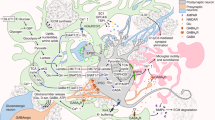Summary.
Extrasynaptic communication between neurons or neurons and glia is mediated by the diffusion of neuroactive substances through the extracellular space (ECS). Structural changes and amino acid release occurring under physiological and pathological conditions result in cellular (particularly glial) swelling, leading to dynamic changes in the ECS volume and geometry that in turn affect ECS diffusion. Significant changes in ECS volume and in diffusion barriers occur during development and aging. They are often the result of cell death, astrogliosis, the rearrangement of astrocytic processes and changes in extracellular matrix molecules. Plastic changes in ECS volume, geometry and anisotropy significantly affect the spatial relation of glial processes towards synapses, glutamate or GABA ‘spillover’, synaptic cross-talk and neuron-glia communication/interaction. In addition, changes occurring during pathological states can be important for diagnosis, drug delivery and treatment.
Similar content being viewed by others
Author information
Authors and Affiliations
Rights and permissions
About this article
Cite this article
Syková, E. Glia and volume transmission during physiological and pathological states. J Neural Transm 112, 137–147 (2005). https://doi.org/10.1007/s00702-004-0120-4
Received:
Accepted:
Published:
Issue Date:
DOI: https://doi.org/10.1007/s00702-004-0120-4




